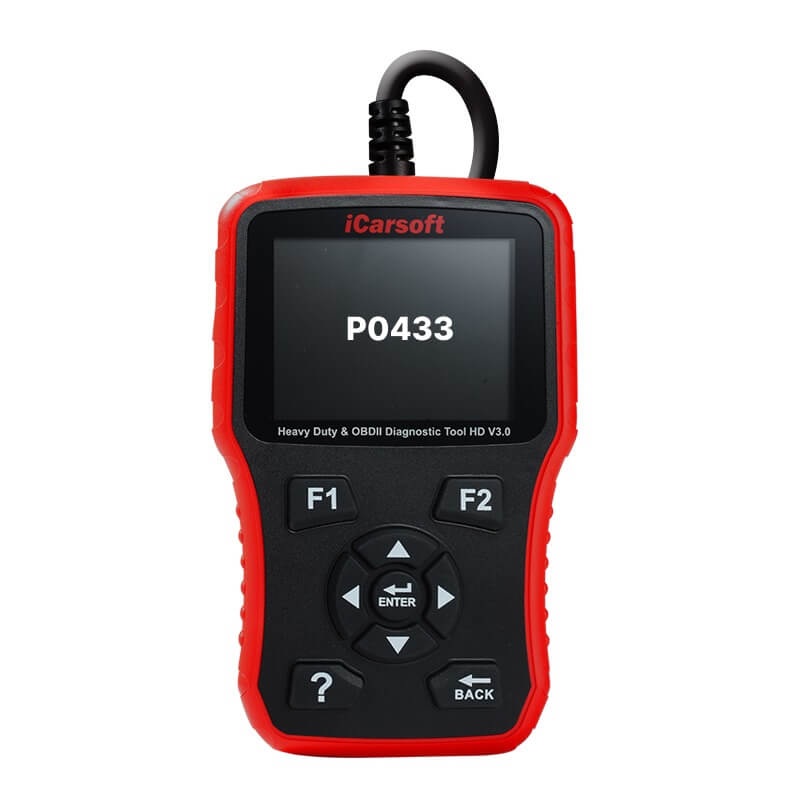P0433 – Heated Catalyst Efficiency Below Threshold Bank 2
POSTED IN pcodes
Welcome to our article on the P0433 code – Heated Catalyst Efficiency Below Threshold Bank 2. In this section, we will discuss the importance of catalyst efficiency, the implications of a low catalyst efficiency, and the significance of bank 2 in vehicle diagnostics. Additionally, we will explore the role of the catalytic converter in engine performance and the steps to diagnose and repair the P0433 code. So, let’s dive in and understand what this code means for your vehicle.
Key Takeaways:
- The P0433 code indicates a heated catalyst efficiency below threshold in bank 2.
- A low catalyst efficiency can lead to reduced fuel efficiency and decreased engine performance.
- Bank 2 refers to the engine bank that does not contain the #1 cylinder.
- Common causes of the P0433 code include faulty sensors, wiring issues, and exhaust leaks.
- Proper vehicle diagnostics and repairs are essential to restore optimal engine performance and fuel efficiency.
Technical Description and Meaning of P0433
The P0433 code is a technical description that indicates insufficient efficiency of the heated catalyst in bank 2. In the vehicle’s exhaust system, the catalytic converter plays a crucial role in reducing harmful emissions by converting particles into harmless ions. When the Powertrain Control Module (PCM) detects a problem with the catalytic converter’s efficiency in bank 2, it stores the P0433 code.
Bank 2 refers to the engine bank that does not contain the #1 cylinder. It is typically located on the opposite side of the engine from bank 1. When the catalytic converter in bank 2 fails to operate at the required efficiency level, emissions issues and reduced engine performance may occur.
It’s important to address the P0433 code promptly and diagnose the underlying problem to restore optimal engine performance and ensure the catalytic converter functions effectively.
Table: Technical Description of P0433
Buy tested tuning file for Adblue / EGR / DPF / Adblue off now!
| Code | Description |
|---|---|
| P0433 | Heated Catalyst Efficiency Below Threshold Bank 2 |
| Meaning | Insufficient efficiency of the heated catalyst in bank 2 |
| OBD-II Code | P0433 |
| Engine Bank | Bank 2 (does not contain the #1 cylinder) |
| OBD-II System | Catalytic Converter Monitoring |
| Impact | Potential emissions issues and reduced engine performance |

Understanding the technical description of the P0433 code is essential in diagnosing and resolving the issue effectively. Let’s explore the severity, symptoms, common causes, and troubleshooting steps associated with this code in the next section.
Code Severity, Symptoms, and Common Causes
When encountering the P0433 code, it is important to understand its severity, recognize the associated symptoms, and identify the common causes. By understanding these aspects, you can take appropriate troubleshooting steps to diagnose and repair the issue efficiently.
Code Severity
The P0433 code should be considered severe as it indicates a malfunction in the fuel delivery system. Ignoring this code may lead to further damage to the catalytic converter and potentially impact the overall engine performance.
Symptoms
The symptoms associated with the P0433 code may manifest in various ways, including:
- Reduced fuel efficiency
- Decreased engine performance
- Activation of the malfunction indicator lamp (MIL)
- Ignition misfires
- Faulty catalytic converter
It’s essential to be observant of these symptoms and take prompt action to address the underlying issue.
Common Causes
Several common causes may trigger the P0433 code. These include:
| Cause | Description |
|---|---|
| Defective mass air flow or manifold air pressure sensor | A malfunctioning or faulty sensor can disrupt the air-fuel mixture, affecting the catalytic converter’s performance. |
| Malfunctioning oxygen sensors | Faulty oxygen sensors may provide inaccurate readings, leading to improper fuel injection and lower catalytic converter efficiency. |
| Broken or disconnected wiring and connectors | Electrical issues such as broken wires or disconnected connectors can disrupt the communication between sensors and the PCM, triggering the P0433 code. |
| Pre-existing exhaust leaks | Exhaust leaks before the catalytic converter can introduce excess oxygen into the system, affecting the converter’s ability to reduce emissions efficiently. |
By examining these common causes, you can narrow down the potential culprits and proceed with the appropriate diagnostic steps.
**Note:** It is essential to conduct a thorough diagnosis to pinpoint the exact cause of the P0433 code. The troubleshooting steps will depend on the specific vehicle make and model, so referring to the manufacturer’s guidelines or seeking professional assistance is recommended for accurate diagnosis and effective repairs.
Vehicle Diagnostics and Repair Tips for P0433
When faced with the P0433 code, it is important to conduct proper vehicle diagnostics to pinpoint the exact cause of the issue. This can involve using OBD-II scanners or diagnostic tools to retrieve and analyze additional trouble codes and sensor data. Once the cause is determined, appropriate repair steps can be taken.
Here are some troubleshooting steps to follow:
- Inspect the catalytic converter for any signs of damage or clogging.
- Check the oxygen sensors to ensure they are functioning correctly.
- Examine the wiring and connectors for any breaks or corrosion.
- Look for any exhaust leaks that may be affecting the catalytic converter’s efficiency.
If you identify faulty sensors, it is recommended to replace them with new ones. Repairing any damaged wiring or connectors can also help resolve the issue. And in cases where the catalytic converter itself is faulty, it may need to be replaced.
If you are not confident in conducting these repairs yourself, it is advisable to seek professional assistance from a certified mechanic or automotive technician.
Alternative solution: In some cases, an alternative solution could be the permanent removal of the P0433 code by uploading the ECU file to a portal. The ECU file modification can eliminate the code and its associated performance issues. However, please note that this method may not be legal or compliant with emissions regulations in certain regions.

Note:
Performing vehicle diagnostics and addressing the issues related to the P0433 code is crucial for maintaining optimal engine performance and fuel efficiency. It is recommended to consult the vehicle’s manual or seek professional guidance when troubleshooting and repairing any complex vehicle systems.
Troubleshooting Steps for P0433
| Steps | Actions |
|---|---|
| 1 | Use OBD-II scanners or diagnostic tools to retrieve trouble codes and sensor data. |
| 2 | Inspect the catalytic converter for damage or clogging. |
| 3 | Check the oxygen sensors for proper functionality. |
| 4 | Examine wiring and connectors for breaks or corrosion. |
| 5 | Look for exhaust leaks that may impact catalytic converter efficiency. |
| 6 | Replace faulty sensors, repair wiring or connectors, or replace the catalytic converter if necessary. |
Impact on Engine Performance and Fuel Efficiency
The P0433 code, indicating low catalyst efficiency below threshold, can have a significant impact on engine performance and fuel efficiency. A malfunctioning catalytic converter may not effectively convert harmful gases into harmless emissions, leading to diminished engine power, decreased fuel efficiency, and potential emissions issues.
When the catalytic converter fails to function optimally, it can restrict the flow of exhaust gases and impede engine performance. This can result in sluggish acceleration, reduced power output, and overall poor engine responsiveness. Additionally, the engine may experience misfires or rough idling due to the inadequate conversion of gases within the catalytic converter.
Addressing the P0433 code promptly and repairing any underlying issues is crucial to restore optimal engine performance. By resolving the low catalyst efficiency problem, the engine can operate more efficiently, resulting in improved power, smoother acceleration, and enhanced overall performance.
Furthermore, a malfunctioning catalytic converter can negatively impact fuel efficiency. When the converter fails to convert toxic gases effectively, it can contribute to higher emissions and lower fuel economy. As a result, the vehicle may consume more fuel to maintain the desired level of performance.
Resolving the P0433 code and ensuring the catalytic converter is functioning properly can help improve fuel efficiency, allowing for more economical and environmentally friendly driving.
It is important to note that the impact on engine performance and fuel efficiency may vary depending on the severity of the issue and the specific vehicle’s design. Professional diagnostics and repair services are recommended to accurately diagnose the problem and implement the necessary repairs or replacements.
Conclusion
In conclusion, the P0433 code indicates a heated catalyst efficiency below threshold in bank 2. The catalytic converter plays a crucial role in reducing exhaust emissions and ensuring optimal vehicle performance. Resolving this issue through thorough vehicle diagnostics, identifying the root cause, and implementing the necessary repairs is essential for maintaining engine performance and fuel efficiency.
Professional assistance is recommended for accurate diagnosis and repair; however, alternative solutions, like ECU file uploads, may be available. Regular maintenance and timely attention to trouble codes like P0433 will contribute to the long-term health and performance of the vehicle. By addressing catalytic converter-related issues promptly, drivers can enjoy optimal engine performance and better fuel economy.
Remember to prioritize vehicle diagnostics and troubleshooting steps to identify common causes such as faulty sensors, broken wiring, or exhaust leaks. Prompt repair and maintenance will help restore the catalytic converter’s efficiency, ensuring reduced emissions and an overall better driving experience. Take proactive steps to address the P0433 code and maintain the long-term reliability of your vehicle.
FAQ
What does the P0433 code mean?
The P0433 code refers to a heated catalyst efficiency below threshold in bank 2, indicating a problem with the catalytic converter for engine bank 2.
What is the technical description of the P0433 code?
The technical description of the P0433 code states that it signifies insufficient efficiency of the heated catalyst in bank 2.
How severe is the P0433 code, and what are the symptoms?
The P0433 code should be considered severe as it indicates a malfunction in the fuel delivery system. Symptoms may include reduced fuel efficiency, decreased engine performance, activation of the malfunction indicator lamp (MIL), ignition misfires, and faulty catalytic converter.
What are the common causes of the P0433 code?
Common causes of the P0433 code include a defective mass air flow or manifold air pressure sensor, malfunctioning oxygen sensors, broken or disconnected wiring and connectors, and pre-existing exhaust leaks.
How can I troubleshoot and repair the P0433 code?
To troubleshoot the P0433 code, proper vehicle diagnostics should be conducted using OBD-II scanners or diagnostic tools. Once the cause is identified, repair steps may include replacing faulty sensors, repairing wiring or connectors, fixing exhaust leaks, or replacing the catalytic converter.
What is the impact of the P0433 code on engine performance and fuel efficiency?
The P0433 code can significantly impact engine performance and fuel efficiency, resulting in reduced engine power, decreased fuel efficiency, and potential emissions issues if the catalytic converter is not functioning optimally.


